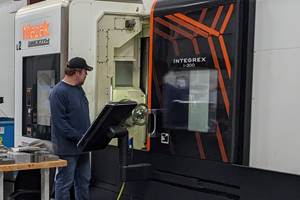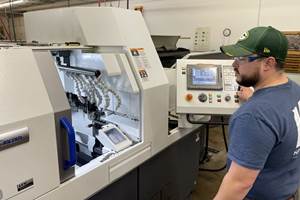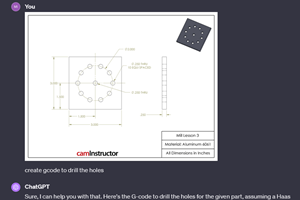Tool Management System Complements DNC
It quickly became apparent to this company that handling the many tools - knowing where the tools were and how many were available - was the horse, and the DNC system was the cart.
Share





In 1997 when Camco Limited decided to replace an older minicomputer-driven distributed numerical control (DNC) system with a PC-based system, one thing led to another for this Belfast (Northern Ireland) subsidiary of Camco International (Houston, Texas). It became apparent that handling the many toolsŌĆöknowing where the tools were and how many were availableŌĆöwas the horse, and the DNC system was the cart. ŌĆ£We realized we were setting assemblies that were moving from the tool room to the machine shop without any control,ŌĆØ relates Jim Heron, production engineer at Camco, a 200-employee shop that makes oil production equipment, such as safety valves and packers for oil wells. He says the company wanted to invest in a PC-based tool management system to see if it had too many of some tools and not enough of others and also to reduce inventory.
Unlike many other users, where costly events trigger the acquisition of a tool management system, Camco recognized that its DNC system would be complemented if it got tooling management under control. ŌĆ£We looked at a couple other systems,ŌĆØ Mr. Heron says, ŌĆ£but AutoTAS and DLoG seemed to work well together.ŌĆØ Camco did have an older tool store control system, but it did not provide tool monitoring to track the location of assemblies as AutoTAS from Micro Estimating Systems (New Berlin, Wisconsin) does. Rather, the older system let users view on a computer screen the quantity of a particular tool that was in stock. ŌĆ£ThatŌĆÖs where it began and ended,ŌĆØ Mr. Heron says.
ŌĆ£We thought AutoTAS had greater potential and seemed to be more user friendly than most weŌĆÖd seen at exhibitions,ŌĆØ Mr. Heron says. Also, he likes the modularity of the AutoTAS system. A company can install only the modules necessary for a particular task. Later, it can install other modules as they became necessary. Camco began with tool store control first. Next it began building tool assemblies and then evolved into data transfer to the machines, connecting AutoTAS to the DNC system.
The advantage of working with modular systems is not simply the reduced learning requirement at one time, nor the advantage of having fewer people involved with a new system. Modularity overcomes a major shortcoming of many non-modular systems: a frequent requirement that all data be present and all functions be operational, or no part of the system can be used.
ŌĆ£Actually, we started with quite a lot at once,ŌĆØ Mr. Heron says. ŌĆ£And as we were building all of that, others in the plant became interested, such as the gauge room and calibration areas.ŌĆØ Now, CamcoŌĆÖs QA department has also moved totally into AutoTAS gauge management and calibration. More recently, the companyŌĆÖs maintenance department added a seat on the stock administration side, and it is entering all spare parts for its machines into AutoTAS.
CamcoŌĆÖs technical buyer, Tom Dougan, is responsible for purchasing tooling. He worked closely with Mr. Heron setting up the AutoTAS item library, and he has become a real enthusiast for the tool management system. Today there are approximately 2,000 tools in the system. Mr. Dougan and Mr. Heron set all the tooling reorder points to enable the system to automatically produce requisitions. Mr. Dougan reviews the system daily and instructs the system to create orders. He and Mr. Heron then review the systemŌĆÖs suggested order(s) together before proceeding. AutoTAS can also generate a purchase order automatically. Today, if Camco Purchasing receives a requisition for any item still having a re-order card from the old system, the first consideration is whether or not the item can be entered into the AutoTAS system and the card thrown away.
Now, the company plans to extend use of the tool management system by linking it to a carousel storage system. The Belfast plantŌĆÖs layout is well suited to a centrally located tool carousel outside the toolroom. The machine shop, assembly area and welding area are each adjacent to the planned carousel location. ŌĆ£The welding area has a stock of items now, as does the assembly department. We feel that a carousel near the tool room would be close enough for someone to walk from any of those areas to get supplies.ŌĆØ And that would bring a lot more supplies under control.
ŌĆ£If we put all of these supplies in the carousel under control of AutoTAS, people wonŌĆÖt be running short of tools any more.ŌĆØ Mr. Heron continues, ŌĆ£We can put the popular items in the carousel and set up the reorder points.ŌĆØ Having now operated a tool management system for almost 2 years, Mr. Heron knows it does far more than keep an accurate tool inventory. ŌĆ£Having a tool management system helps you look and see what youŌĆÖve got, and it helps reduce the inventory level of the tooling.ŌĆØ
Related Content
5 Tips for Running a Profitable Aerospace Shop
Aerospace machining is a demanding and competitive sector of manufacturing, but this shop demonstrates five ways to find aerospace success.
Read MoreERP Provides Smooth Pathway to Data Security
With the CMMC data security standards looming, machine shops serving the defense industry can turn to ERP to keep business moving.
Read MoreCan ChatGPT Create Usable G-Code Programs?
Since its debut in late 2022, ChatGPT has been used in many situations, from writing stories to writing code, including G-code. But is it useful to shops? We asked a CAM expert for his thoughts.
Read MoreTips for Designing CNC Programs That Help Operators
The way a G-code program is formatted directly affects the productivity of the CNC people who use them. Design CNC programs that make CNC setup people and operators’ jobs easier.
Read MoreRead Next
Last Chance! 2025 Top Shops Benchmarking Survey Still Open Through April 30
Don’t miss out! 91╩ėŲĄ═°šŠ╬█'s Top Shops Benchmarking Survey is still open — but not for long. This is your last chance to a receive free, customized benchmarking report that includes actionable feedback across several shopfloor and business metrics.
Read MoreAMRs Are Moving Into Manufacturing: 4 Considerations for Implementation
AMRs can provide a flexible, easy-to-use automation platform so long as manufacturers choose a suitable task and prepare their facilities.
Read MoreMachine Shop MBA
Making Chips and 91╩ėŲĄ═°šŠ╬█ are teaming up for a new podcast series called Machine Shop MBA—designed to help manufacturers measure their success against the industry’s best. Through the lens of the Top Shops benchmarking program, the series explores the KPIs that set high-performing shops apart, from machine utilization and first-pass yield to employee engagement and revenue per employee.
Read More






















